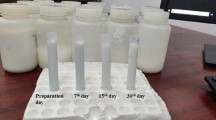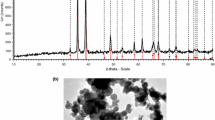Abstract
In the present study, the pure MCM-41- and CuO-doped MCM-41 nanoparticles with various mass fractions of CuO were synthesized and used for the preparation of water-based nanofluids. The obtained nanoparticles were characterized using small-angle X-ray scattering, scanning electron microscopy, transmission electron microscopy and N2 adsorption/desorption analysis. The thermal conductivity of the water-based nanofluids with various mass fractions of nanoparticles including 0.1, 0.5 and 1 mass% was measured by KD2-Pro thermal analyzer. A new correlation is developed for the thermal conductivity of the nanofluid with a reasonably good accuracy (± 5%) when comparing to the experimental data. The thermal performance of these nanofluids together with hydraulic features such as friction factor and heat transfer coefficient was investigated using a mini-channel heat exchanger. The obtained results revealed that the thermal conductivity can be enhanced by 13.1% which belonged to the nanofluid with 1 mass% of CuO-doped MCM-41 nanoparticles. The maximum heat transfer coefficient enhancement was 31% and belonged to the nanofluid containing 50% CuO@MCM-41 nanoparticles at 0.5 mass%. The performance evaluation criterion (PEC) of the various nanofluids was also calculated, and it was identified that the nanoparticles with 50% CuO@MCM-41 dispersed in water have the largest PEC, 16.7% over the base fluid. The friction factor increases by adding the nanoparticles to the pure water. For example, at Re = 1200, the friction factor increases about 36.84% by using the 50%CuO@MCM-41 nanoparticles with 0.5 mass% as compared with the pure water. The friction factor decreases with increasing the Reynolds number. For example, for 50%CuO@MCM-41 and 0.5 mass%, the friction factor decreases up to 34.17% as the Reynolds number increases in the range of 400–1200.















Similar content being viewed by others
Abbreviations
- a :
-
Effective cross-sectional area of one adsorbate molecule, in square meters, 0.162 nm2 for nitrogen
- A t :
-
Total heat transfer area, m2
- C :
-
Dimensionless constant related to enthalpy of adsorption of adsorbate gas on powder sample
- C p :
-
Specific heat capacity, J kg−1 K−1
- D h :
-
Hydraulic diameter, m
- \( f \) :
-
Darcy friction factor
- H :
-
Heat transfer coefficient, W m−2 K−1
- H c :
-
Height of channel, m
- I :
-
Current, A
- K :
-
Thermal conductivity, W m−1 K−1
- L c :
-
Length of channel
- m :
-
Mass of test powder, g
- \( \dot{m} \) :
-
Mass flow rate, kg s−1
- N :
-
Avogadro constant, 6.022 × 1023 mol−1
- Nu:
-
Nusselt number
- ΔP :
-
Pressure drop, Pa
- P :
-
Partial vapor pressure of adsorbate gas in equilibrium with the surface at 77 K (b.p. of liquid nitrogen), Pa
- P 0 :
-
Saturated pressure of adsorbate gas, Pa
- PEC:
-
Performance evaluation criterion
- Q :
-
Heat, W
- Re:
-
Reynolds number
- T :
-
Temperature, K
- U :
-
Velocity, m s−1
- V :
-
Voltage, V
- V a :
-
Volume of gas adsorbed at standard temperature and pressure (273.15 K and 1.013 × 105 Pa), mL
- V m :
-
Volume of gas adsorbed at standard temperature and pressure to produce an apparent monolayer on sample surface, mL
- W c :
-
Width of channel, m
- avg:
-
Average
- B:
-
Balk
- Bf:
-
Base fluid
- F:
-
Fluid
- in:
-
Inlet
- nf:
-
Nanofluid
- out:
-
Outlet
- P:
-
Nanoparticle
- w:
-
Wall
- ρ :
-
Density, kg m−3
- µ :
-
Viscosity, kg m−1 s−1
- φ :
-
Volume fraction of particle
References
Choi S, Eastman JA. Enhancing thermal conductivity of fluids with nanoparticles. In: Siginer DA, Wang HP (eds) Developments and applications of non-newtonian flows, FED, vol 231/MD, New York: 1995.
Das SK, Putra N, Thiesen P, Roetzel W. Temperature dependence of thermal conductivity enhancement for nanofluids. J Heat Transf. 2003;125(4):567–74.
Shalkevich N, Escher W, Bürgi T, Michel B, Si-Ahmed L, Poulikakos D. On the thermal conductivity of gold nanoparticle colloids. Langmuir. 2010;26(2):663–70.
Shah J, Gupta SK, Sonvane Y, Davariya V. Review: enhancing efficiency of solar thermal engineering systems by thermophysical properties of a promising nanofluids. Renew Sustaina Energy Rev. 2017;77:1343–8.
Sundar LS, Singh MK, Punnaiah V, Sousa ACM. Experimental investigation of Al2O3/water nanofluids on the effectiveness of solar flat-plate collectors with and without twisted tape inserts. Renew Energy. 2018;119:820–33.
Yang L, Du K. A comprehensive review on heat transfer characteristics of TiO2 nanofluids. Int J Heat Mass Transf. 2017;108:11–31.
Yan S, Wang F, Shi Z, Tian R. Heat transfer property of SiO2/water nanofluid flow inside solar collector vacuum tubes. Appl Thermal Eng. 2017;118:385–91.
Agarwal R, Verma K, Agrawal NK, Duchaniya RK, Singh R. Synthesis, characterization, thermal conductivity and sensitivity of CuO nanofluids. Appl Thermal Eng. 2016;102:1024–36.
Yang J-C, Li F-C, He Y-R, Huang Y-M, Jiang B-C. Experimental study on the characteristics of heat transfer and flow resistance in turbulent pipe flows of viscoelastic-fluid-based Cu nanofluid. Int J Heat Mass Transf. 2013;62:303–13.
Hemmat Esfe M, Saedodin S, Biglari M, Rostamian H. An experimental study on thermophysical properties and heat transfer characteristics of low volume concentrations of Ag-water nanofluid. Int Commun Heat Mass Transf. 2016;74:91–7.
Ternik P. Conduction and convection heat transfer characteristics of water–Au nanofluid in a cubic enclosure with differentially heated side walls. Int J Heat Mass Transf. 2015;80:368–75.
Hashemzadeh S, Hormozi F. An experimental study on hydraulic and thermal performances of hybrid nanofluids in mini-channel. J Therm Anal Calorim. 2019. https://doi.org/10.1007/s10973-019-08626-6.
Barewar SD, Chougule SS, Jadhav J, Biswas S. Synthesis and thermo-physical properties of water-based novel Ag/ZnO hybrid nanofluids. J Therm Anal Calorim. 2018;134:1493–504.
Hosseinirad E, Hormozi F. Performance intensification of miniature channel using wavy vortex generator and optimization by response surface methodology: MWCNT-H2O and Al2O3-H2O nanofluids as coolant fluids. Chem Eng Process Process Intensif. 2018;124:83–96.
Sarbazi Z, Hormozi F. Optimization of thermal and hydraulic performance of nanofluids in a rectangular miniature-channel with various fins using response surface methodology. J Therm Anal Calorim. 2019;137:711–33.
Bahrami Z, Badiei A, Ziarani GM. Carboxylic acid-functionalized SBA-15 nanorods for gemcitabine delivery. J Nanopart Res. 2015;17(125):2–12.
Giraldo LF, Pérez L, Urrego S, Sierra L, Mesa M. Mesoporous silica applications. Macromol Symp. 2007;258:129–41.
Bahrami Z, Badiei A, Atyabi F. Surface functionalization of SBA-15 nanorods for anticancer drug delivery. Chem Eng Res Des. 2014;92:1296–303.
Bahrami Z, Badiei A, Atyabi F, Darabi HR, Mehravi B. Piperazine and its carboxylic acid derivatives-functionalized mesoporous silica as nanocarriers for gemcitabine: adsorption and release study. Mater Sci Eng, C. 2015;49:66–74.
Nejat T, Jalalinejad P, Hormozi F, Bahrami Z. Hydrogen production from steam reforming of ethanol over Ni–Co bimetallic catalysts and MCM-41 as support. J Taiwan Inst Chem Eng. 2019. https://doi.org/10.1016/j.jtice.2019.01.025.
Suganthi KS, Rajan KS. Metal oxide nanofluids: review of formulation, thermo-physical properties, mechanisms, and heat transfer performance. Renew Sustain Energy Rev. 2017;76:226–55.
Tadjarodi A, Zabihi F. Thermal conductivity studies of novel nanofluids based on metallic silver decorated mesoporous silica nanoparticles. Mater Res Bull. 2013;48:4150–6.
Naraki M, Peyghambarzadeh SM, Hashemabadi SH, Vermahmoudi Y. Parametric study of overall heat transfer coefficient of CuO/water nanofluids in a car radiator. Int J Therm Sci. 2013;66:82–90.
Saboori R, Sabbaghi S, Barahoei M, Sahooli M. Improvement of thermal conductivity properties of drilling fluid by CuO nanofluid. Transp Phenom Nano Micro Scales. 2017;5(2):97–101.
Saedodin S, Kashefi MH, Bahrami Z. Experimental study on the rheological behavior of nanolubricant-containing MCM-41 nanoparticles with viscosity measurement. J Therm Anal Calorim. 2019. https://doi.org/10.1007/s10973-019-08074-2.
Raja S, Vijayakumar K, Gangadevi R. A comparative study on thermal conductivity of Al2O3/water, CuO/water and Al2O3 – CuO/water nanofluids. Dig J Nanomater Biostruct. 2015;10(4):1449–58.
Kline SJ. Describing uncertainty in single-sample experiments. Mech Eng. 1953;75:3–8.
Nakhjavani M, Nikkhah V, Sarafraz M, Shoja S, Sarafraz M. Green synthesis of silver nanoparticles using green tea leaves: experimental study on the morphological, rheological and antibacterial behaviour. Heat Mass Transf. 2017;53(10):3201–9.
Nikkhah V, Sarafraz M, Hormozi F. Application of spherical copper oxide (II) water nano-fluid as a potential coolant in a boiling annular heat exchanger. Chem Biochem Eng Q. 2015;29(3):405–15.
Sarafraz M, Hormozi F, Peyghambarzadeh S, Vaeli N. Upward flow boiling to DI-water and cuo nanofluids inside the concentric annuli. J Appl Fluid Mech. 2015;8(4):651–9.
Sarafraz M, Hormozi F, Silakhori M, Peyghambarzadeh S. On the fouling formation of functionalized and non-functionalized carbon nanotube nano-fluids under pool boiling condition. Appl Therm Eng. 2016;95:433–44.
Sarafraz M, Nikkhah V, Madani S, Jafarian M, Hormozi F. Low-frequency vibration for fouling mitigation and intensification of thermal performance of a plate heat exchanger working with CuO/water nanofluid. Appl Therm Eng. 2017;121:388–99.
Sarafraz M, Peyghambarzadeh S, Alavi Fazel S, Vaeli N. Nucleate pool boiling heat transfer of binary nano mixtures under atmospheric pressure around a smooth horizontal cylinder. Period Polytech Chem Eng. 2013;57(1–2):71–7.
Wang X-Q, Mujumdar AS. Heat transfer characteristics of nanofluids: a review. Int J Therm Sci. 2007;46(1):1–19.
White FM. Fluid mechanics. 7th ed. New York: McGraw-Hill; 2011.
Nooney RI, Thirunavukkarasu D, Chen Y, Josephs R, Ostafin AE. Synthesis of nanoscale mesoporous silica spheres with controlled particle size. Chem Mater. 2002;14(11):4721–8.
Szegedi Á, Kónya Z, Méhn D, Solymár E, Pál-Borbély G, Horváth ZE, et al. Spherical mesoporous MCM-41 materials containing transition metals: synthesis and characterization. Appl Catal A Gen. 2004;272(1–2):257–66.
Xu W, Gao Q, Xu Y, Wu D, Sun Y, Shen W, et al. Controllable release of ibuprofen from size-adjustable and surface hydrophobic mesoporous silica spheres. Powder Technol. 2009;191(1):13–20.
Kulkarni DP, Namburu PK, EdBargar H, Das DK. Convective heat transfer and fluid dynamic characteristics of SiO2 ethylene glycol/water nanofluid. Heat Transf Eng. 2008;29(12):1027–35.
Manzano M, Aina V, Areán CO, Balas F, Cauda V, Colilla M, et al. Studies on MCM-41 mesoporous silica for drug delivery: effect of particle morphology and amine functionalization. Chem Eng J. 2008;137(1):30–7.
Cauda V, Schlossbauer A, Bein T. Bio-degradation study of colloidal mesoporous silica nanoparticles: effect of surface functionalization with organo-silanes and poly(ethylene glycol). Microporous Mesoporous Mater. 2010;132(1–2):60–71.
Sarafraz M, Arjomandi M. Demonstration of plausible application of gallium nano-suspension in microchannel solar thermal receiver: experimental assessment of thermo-hydraulic performance of microchannel. Int Commun Heat Mass Transf. 2018;94:39–46.
Acknowledgements
The authors would appreciate Semnan University for the financial supports.
Author information
Authors and Affiliations
Corresponding author
Additional information
Publisher's Note
Springer Nature remains neutral with regard to jurisdictional claims in published maps and institutional affiliations.
Rights and permissions
About this article
Cite this article
Kiaee, F.M., Bahrami, Z. & Hormozi, F. Experimental investigation on the thermal performance and new correlation for thermal conductivity of aqueous copper oxide-doped MCM-41 nanofluids. J Therm Anal Calorim 140, 1443–1455 (2020). https://doi.org/10.1007/s10973-019-08832-2
Received:
Accepted:
Published:
Issue Date:
DOI: https://doi.org/10.1007/s10973-019-08832-2




